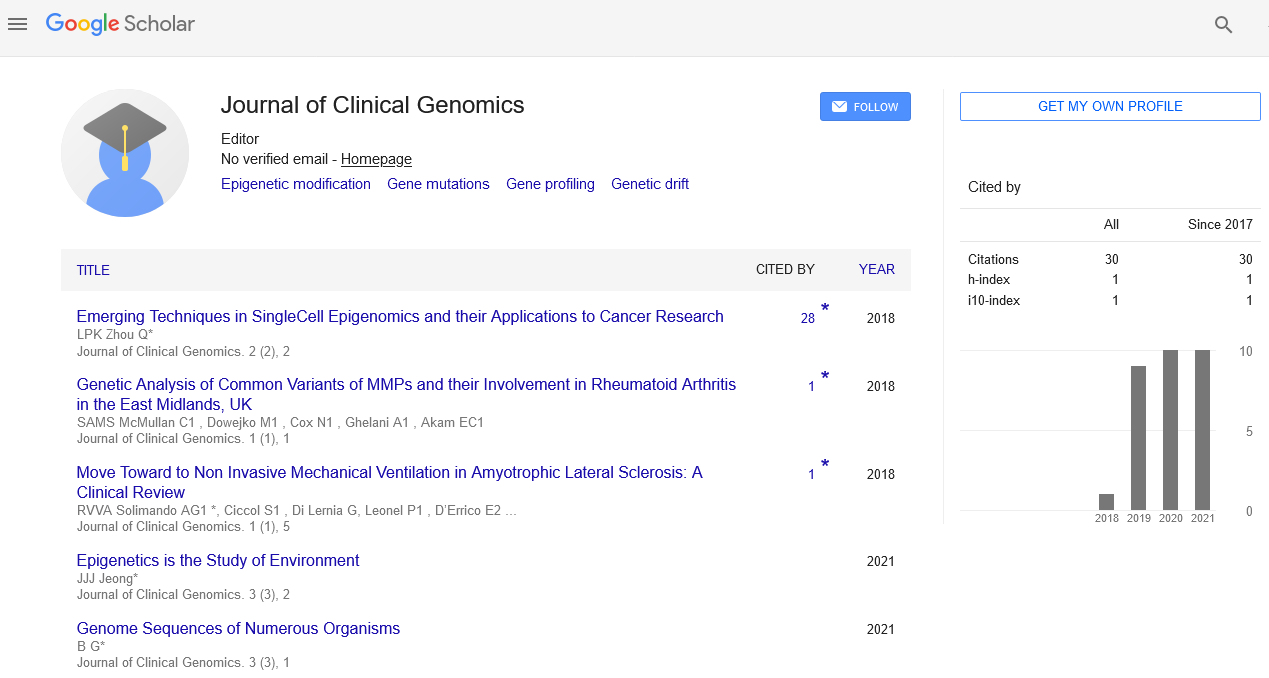Commentary, J Clin Genom Vol: 5 Issue: 4
Examining the Role of Next Generation Sequencing in Genomics
Sevro Matthews*
1Department of Pathology, University of Utah, Salt Lake City, United States of America
*Corresponding Author: Sevro Matthews,
Department of Pathology, University
ofUtah, Salt Lake City, United States of America
E-mail: sevro_matthews@uu11.edu
Received date: 22 November, 2023, Manuscript No. JCG-24-125704;
Editor assigned date: 24 November, 2023, PreQC No. JCG-24-125704 (PQ);
Reviewed date: 11 December, 2023, QC No. JCG-24-125704;
Revised date: 19 December, 2023, Manuscript No. JCG-24-125704 (R);
Published date: 26 December, 2023, DOI: 110.4172/JCG.1000149
Citation: Matthews S (2023) Examining the Role of Next Generation Sequencing in Genomics. J Clin Genom 5:4.
Description
The advent of Next Generation Sequencing (NGS) technologies has ushered in a transformative era in genomics, revolutionizing the ability to decode and understand the complexities of the genetic code. It explores the pivotal role that NGS plays in genomics, examining its applications, methodologies, and the profound impact it has had on advancing the understanding of genetic information. Next Generation Sequencing encompasses a suite of high-throughput sequencing techniques that collectively allow analysts to sequence DNA and RNA with unprecedented speed, accuracy, and cost-effectiveness.
The major NGS methodologies include, Illumina sequencing, a widely adopted NGS platform, employs a process known as reversible terminator sequencing. DNA fragments are attached to a solid surface, and as nucleotides are incorporated into the growing DNA strand, fluorescent signals are detected, enabling the determination of the sequence with high precision. In 454 Pyrosequencing, DNA is fragmented, and each fragment is attached to a bead. These beads are then amplified in tiny wells and sequenced using a series of enzymatic reactions that release light with each nucleotide incorporation. This light is detected and used to determine the sequence.
Ion Torrent sequencing is based on the detection of hydrogen ions released during DNA synthesis. As nucleotides are added to the growing DNA strand, hydrogen ions are released, and their detection allows real-time sequencing without the need for optical detection systems. Pacific Biosciences (PacBio) sequencing utilizes Single- Molecule Real-Time (SMRT) technology. DNA polymerase synthesizes the DNA strand while attached to a zero-mode waveguide, and the incorporation of labeled nucleotides is observed in real-time, allowing for long-read sequencing. NGS has enabled the rapid and cost-effective sequencing of entire genomes, revolutionizing the understanding of genetic diversity within and between species. This has led to innovative findings in areas such as human genetics, personalized medicine, and comparative genomics.
The study of gene expression, known as transcriptomics, has been greatly enhanced by NGS. Experts can now comprehensively analyze the entire transcriptome, identifying all RNA molecules present in a sample. This has implications for understanding cellular processes, developmental biology, and disease mechanisms. NGS plays an essential role in studying epigenetic modifications, providing insights into how DNA methylation, histone modifications, and non-coding RNAs influence gene expression. This has implications for understanding development, disease, and the impact of environmental factors on the epigenome.
Metagenomics involves the study of genetic material recovered directly from environmental samples. NGS facilitates the exploration of microbial communities, allowing for the identification of diverse microorganisms and the elucidation of their functional roles in ecosystems. NGS has significantly advanced the understanding of cancer genetics. Through the comprehensive analysis of cancer genomes, anlaysts can identify driver mutations, characterize tumor heterogeneity, and develop targeted therapies tailored to individual patients.
NGS technologies provide unparalleled high efficiency, allowing for the simultaneous sequencing of millions of DNA fragments. This scalability and efficiency have substantially reduced the cost per base pair, democratizing access to genomic information. The ability to generate vast amounts of sequencing data has led to the discovery of novel genomic elements, such as non-coding RNAs, regulatory elements, and structural variants. These findings have expanded the understanding of genome complexity and function.
NGS has paved the way for personalized medicine by allowing clinicians to analyze an individual's genomic makeup and tailor medical interventions accordingly. This has implications for the diagnosis, treatment, and prevention of genetic disorders and complex diseases. The speed and precision of NGS have accelerated biological and medical studies across diverse fields. From evolutionary biology to infectious disease surveillance, analysts can now address complex questions and generate data at an unprecedented scale.
Conclusion
In conclusion, Next generation sequencing has become an indispensable tool in genomics, propelling the understanding of intricacies of the genetic code to new heights. From unraveling the mysteries of the human genome to exploring the diversity of microbial life, NGS has transformed the landscape of biological studies. As technology continues to evolve, the role of NGS in genomics will likely expand, driving further findings and innovations that hold the potential of revolutionizing the understanding of life at the molecular level.
 Spanish
Spanish  Chinese
Chinese  Russian
Russian  German
German  French
French  Japanese
Japanese  Portuguese
Portuguese  Hindi
Hindi 